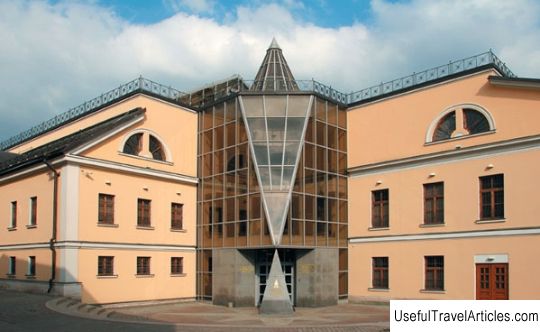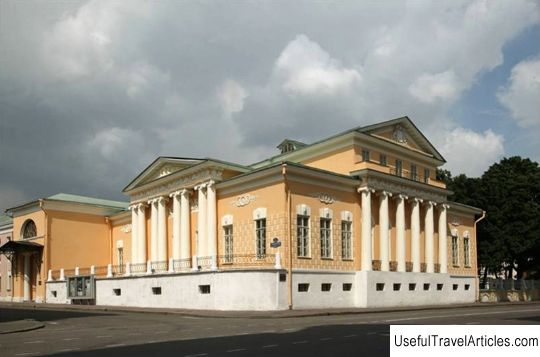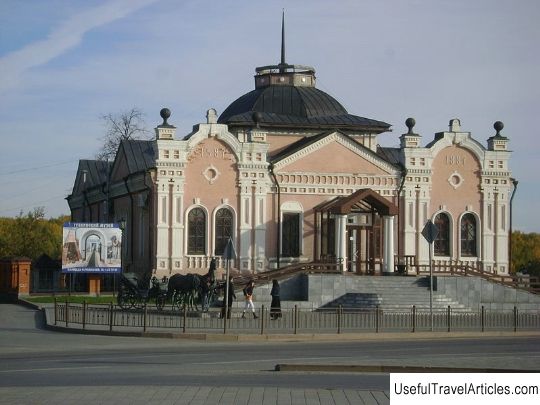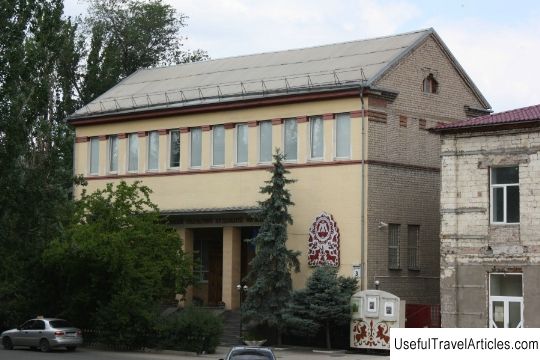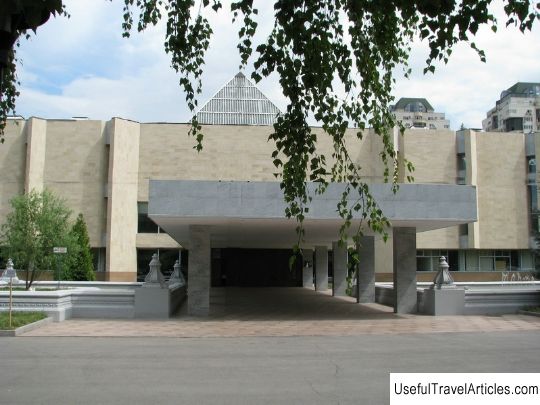Museum of Fine Arts. A. S. Pushkin description and photo - Russia - Moscow: Moscow
Rating: 8,8/10 (1849 votes) 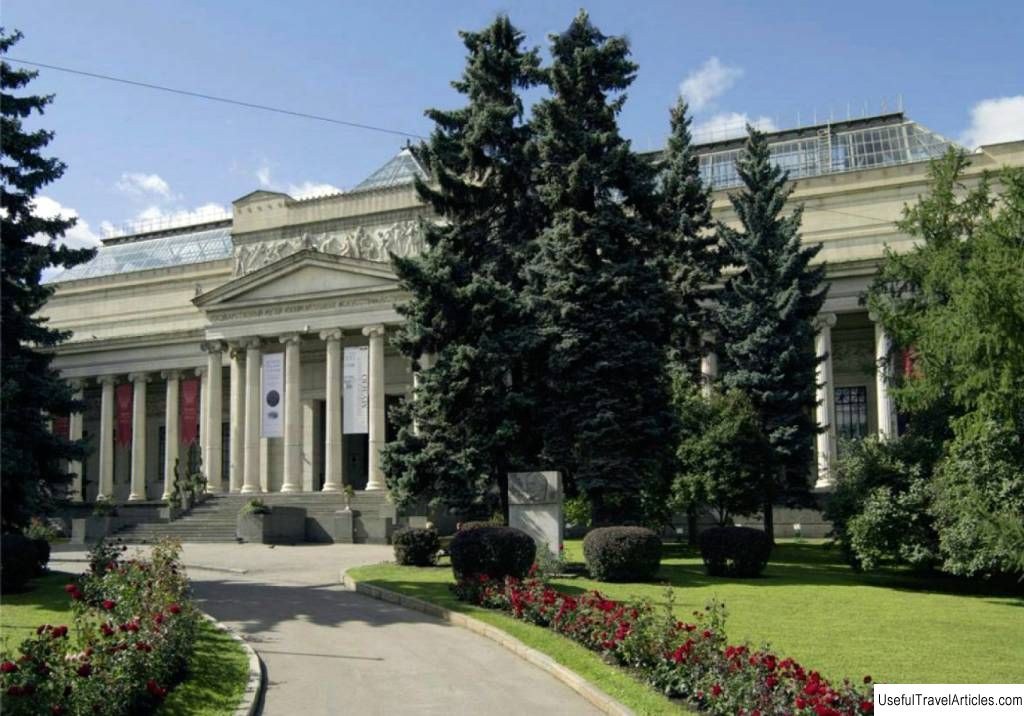
Museum of Fine Arts. A.S. Pushkin description and photo - Russia - Moscow: Moscow. Detailed information about the attraction. Description, photos and a map showing the nearest significant objects. Photo and descriptionForeign art is presented in Moscow at the State Museum of Fine Arts. A.S. Pushkin. Founded in 1912 the museum has at least 700 thousand items today . Among the exhibits of the Pushkin Museum are archaeological finds, works of artists from around the world, a collection of ancient Egyptian and Roman rarities. The museum is in the register of especially valuable objects of cultural heritage of the peoples of the Russian Federation. History of the Museum. PushkinThe father of the Russian poetess Marina Tsvetaeva is called the founder of the Moscow Museum of Foreign Art. In 1894 Ivan Tsvetaev made a proposal to create a training museum at the First Congress of Russian Artists. It was assumed that the exposition will help to present all stages of the development of world art: from the Ancient World through the Middle Ages to the times of the Renaissance. Tsvetaev showed the layout of the future building to Emperor Nicholas II , who immediately allocated 200 thousand rubles for the project. Soon other investors joined in: the Yusupov princes, the merchant Alekseeva, the industrialist Nechaev and the architect Fyodor Shekhtel. The foundation stone of the building was soon laid, and His Imperial Highness Grand Duke Sergei Alexandrovich took over the patronage of the future museum. It was decided to place the museum's exposition in a mansion specially built for this purpose. In 1896 g. the competition was announced, in which the victory was won by Roman Klein and Ivan Rerberg . But after eight years, the main building was badly damaged in a fire. It was restored by 1912 After the completion of all the work, the mansion was a neoclassical structure, similar to an ancient temple. The facade was accentuated by Ionic columns, and the glass vaults on the ceiling allowed the exhibits to look particularly advantageous in natural light. The interiors were decorated with murals and panels made by a group of artists headed by I. Nivinsky . The artists Korovin, Grabar and Polenov provided invaluable assistance in the design of the exposition to Tsvetaev. Famous scientists took part in the creation of the museum: Egyptologist V. Golenishchev, historian and archaeologist N. Kondakov and author of "History of Russia" D. Ilovaisky. Difficult twentieth centuryThe collection was formed in the period from 1909 to 1911. Then the museum was replenished with ancient Egyptian rarities, paintings by masters of the Middle Ages and the Renaissance, and some canvases by Russian painters. The museum acquired archaeological finds from Ancient Egypt from V. Golenishchev, a well-known orientalist and explorer of ancient civilizations at that time. Italian painting and sculpture appeared in the Pushkin Museum thanks to Princess Elizaveta Fedorovna and diplomat M. Shchekin . Some of the exhibits were donated to the museum by the archaeologist A. Bobrinsky , the organizers bought other works of art from famous Russian scientists. It was impossible to acquire authentic antique sculptures, therefore, the museum was replenished with plaster copies and casts of the most famous antique works of art. The official opening took place on May 31, 1912. The ceremony was attended by Emperor Nicholas II with his mother and daughters . The museum quickly became very popular and began to enjoy particular success among students and teachers of higher educational institutions and the capital's intelligentsia. Until 1917, the Museum of Fine Arts at Moscow University was named after Alexander III. The revolution suspended work for a long time, and the Museum of Fine Arts at Moscow University, which had lost the name of the tsar in its name, reopened only in 1920. His new mission was to exhibit projects of the Liberated Labor monument. Soon a workshop was opened at the museum, where Soviet sculptors worked on the creation of works intended to revitalize parks, squares and other public spaces. In particular, the famous "Girl with an oar" for the park of culture and recreation named after Gorky was born in the building on Volkhonka, 12. The name of the great Russian poet was given to the museum in 1937 The war years were a difficult test for the staff of the Pushkin Museum. Pushkin. The collection was evacuated to Siberia, and the building on Volkhonka was damaged by enemy bombing. The museum reopened after renovation and reconstruction in 1946. Three years later, its area was given over to an exhibition of gifts that arrived in Moscow for the 70th anniversary of Stalin. The exhibits of the museum were removed to the storerooms for a long eight years and were again presented to the public only after the death of the leader of the Soviet state. At the Pushkin Museum. Pushkin began to host exhibitions of famous works of world art. At first, the public was shown pictures taken out from the Dresden gallery after the victory in the Great Patriotic War. In 1956, Muscovites and guests of the capital were able to visit an exhibition of paintings by Picasso , and in 1985, to see Gioconda Leonardo and works brought to Moscow from the New York Metropolitan Museum. The centenary of the Pushkin Museum. Pushkin was marked by the release of a series of commemorative medals and a postage stamp. What to see in the Pushkin Museum in MoscowSculptures by Rodin, J.-B. Lemoine, Claudion and E. Bourdelle.More than 350 thousand paintings include a painting collection of the Pushkin Museum. Pushkin. The paintings are exhibited in chronological order, and the exposition opens in a hall of the 1st century, in which Fayum portraits , made in the technique of easel painting, are presented. In the museum you can see the works of Durer and Rembrandt, Bryullov and Vrubel, Callot and Mantegna . Flemish art is represented by paintings by Pieter Brueghel the Younger, Rubens and Van Dyck , and among the works of famous Italians - paintings by Caravaggio, Strozzi and Guido Reni . Many canvases depict biblical scenes; there are also hagiographic icons in the museum's collection, the authors of which created in the 13th century. in Naples, Florence and Siena. The most famous painting masterpieces of the Pushkin Museum - "Girl on a Ball" Picasso , "Portrait of Jeanne Samary" Renoir , "Madonna in the Vineyard" Lucas Cranach the Elder , "Blue Dancers" Degas , "Breakfast on the Grass" Monet and "Artaxerxes, Haman and Esther" Rembrandt . The oldest collection of Egyptian rarities contains exhibits dating from the IV century. BC e. until the IV century. The museum stands display burial sarcophagi and sculptural compositions, papyri and figurines, amulets and stone tools. Collection of the engraving cabinet of the Pushkin State Museum of Fine Arts Pushkin moved here from the Rumyantsev Museum . It was collected by Dmitry Rovinsky, a Russian lawyer and art historian. The museum displays engravings from the 16th-19th centuries. and, including drawings by Benoit, Serov, Vrubel and Repin. One of the richest numismatic collections in the world, Pushkin's collection of coins, medals and casts from carved stones consists of more than 200 thousand items. The numismatic department presents four collections - antique, eastern, western European and Russian. Branches and branches of the museum In addition to the main building on Volkhonka, 12 Pushkin Museum im. Pushkin has several branches: - In the former Golitsyns' estate on Volkhonka, 14, a gallery was opened in 2006, where you can see paintings by contemporary masters from Western Europe . The collection features the work of Delacroix, Rousseau and Delaroche. Several rooms of the mansion are dedicated to the French fine arts of the 19th-20th centuries. They contain works by Monet, Cezanne, Gauguin, Manet, Picasso and Matisse. Fans of the Russian avant-garde will meet in the halls of the gallery with canvases by Kandinsky and Chagall. - Countess Shuvalova's house at 10 Volkhonka presents to the viewer the collections collected by famous Russian art critics and figures and culture. In the museum you can get acquainted with the private collections of Svyatoslav Richter, Fyodor Lemkul and the Vereisky family. - An old mansion of the late 18th century. became in 2006 another department of the Pushkin Museum im. Pushkin. In house number 6 in Kolymazhny lane, the Center for aesthetic education of children and youth "Museion" was opened . - After the founder of the museum was named its branch on the street. Chayanova, 15. Educational Art Museum. Ivan Tsvetaeva was opened in 1996 at the Russian State Humanitarian University. Its halls exhibit over 750 casts of antique sculptures stored in world museums. - After reconstruction, a collection of paintings by old masters - Boucher, Murillo, Rembrandt, Rubens and Titian will be placed in the Vyazemsky-Dolgorukov estate at 3/5 in Maly Znamensky lane. p> - Everything related to printing will be presented to the viewer in the House of Text in Maly Znamensky Pereulok, 8/1 . In this branch of the museum, visitors can also get acquainted with rare books and become readers of the scientific library. In the near future, a depository with restoration workshops and an exposition in Tarusa dedicated to nonconformist artists will also open. Notes
      We also recommend reading Syuyumbike tower of the Kazan Kremlin description and photos - Russia - Volga region: Kazan Topic: Museum of Fine Arts. A. S. Pushkin description and photo - Russia - Moscow: Moscow. |

